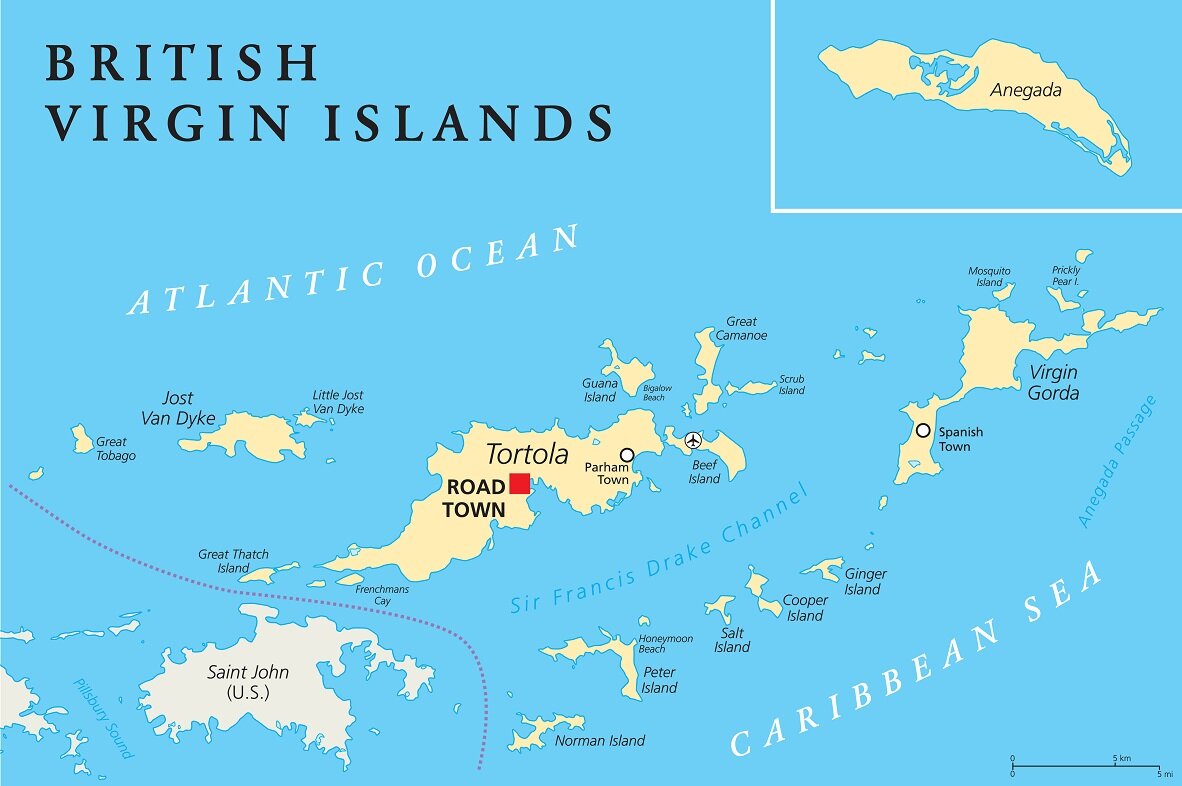A volcanic archipelago, the British Virgin Islands, (BVI) is a collection of 60 islands in the Caribbean Sea. Before the voyages of Christopher Columbus, when he named the islands, and before Spain claimed the islands as their own, and the subsequent settlements by English, Dutch, French, Spanish, and Danish people, the Virgin Islands were inhabited by indigenous peoples. Tortola became a permanent Dutch settlement as the cluster of islands became a famous outpost for pirates. Skirmishes between the European countries seeking New World dominance changed the balance of power frequently in the 17th century. Eventually, the English seized Tortola and annexed nearby Virgin Gorda and Anegada.
Before realizing the economic powerhouse in their possession, the English were interested in the Virgin Islands’ strategic location. Soon sugar cane became the cornerstone of the economy, and the industry boomed as the enslaved peoples of West Africa were put to work on the cane plantations. However, the economy declined when the mid-nineteenth century brought abolition, devastating storms, and decreased demand for cane sugar. Currently, the economy centers around financial services and tourism.
Road Town - Tortola
The capital of BVI is Road Town, located onTortola, which is the most populous of the islands.
Old Government House Museum: Waterfront Drive, Road Town, Tortola, 284-494–4091
Possibly one of the best on the islands, this museum celebrates BVI’s evolution from a Caribbean outpost and pirate enclave to a modern territory of the United Kingdom. Over the last two centuries, the destructive effects of several hurricanes created upheaval and necessitated multiple rebuildings of the Governor’s House. Currently, there is a continuing effort to rebuild after the devastation of Hurricane Irma in 2016. The museum features period furnishings and fixtures, breathtaking murals depicting scenes of the islands’ plantation era, and memorabilia from two visits by the Queen of England. For an acquatic adventure, visit Rhone Marine National Park which is the island’s most popular SCUBA dive spot. The wreck of the RMS Rhone has become a reef habit hosting many species of fish and other fascinating sea creatures you won’t want to miss.
Virgin Gorda
The third-largest island, Virgin Gorda, is a place of unspoiled beaches, protected anchorages, and unrivaled natural beauty.
Devil's Bay (The Baths) National Park
Named Virgin Gorda’s #1 attraction, Devil’s Bay, and the Baths are a quick trip from Spanish Town, the island’s “downtown.” With its unique geological formations, the Baths is a favorite for snorkeling, swimming, and stunning granite formations, including arches and caverns. Nearby Devil’s Bay is accessible via steps with rope handrails and a series of ladders that lead up the face of the 40-foot boulders. Onshore amenities include restrooms and lockers.
Jost Van Dyke
The smallest of the islands, Jost Van Dyke’s Great Harbour is the place to be if you’re a party animal. Foxy’s Taboo is a popular stop for locals and tourists alike.
The Bubbly Pool
On the east end of the island, the Bubbly Pool is also called Mother Nature’s Jacuzzi. Bring sturdy shoes, your passport, and a drink. As you hike, you may spot some wild goats! One caveat: Mother Nature is mighty, and visitors must be mindful of their personal safety when the tide is high.
Anegada
This coral island is unique as the other islands are volcanic in origin. Sixteen square miles and flat as can be, Anegada is home to flamingoes, sea turtles, native rock iguanas; nurse sharks are abundant in springtime.
SCUBA, snorkeling, and white beach expanses are waiting for you. Explore the underwater shipwrecks within the coral reefs. Equipment rental is easy to find: kite- and windsurfing, fishing gear, paddleboards, and diving equipment. The shallow water allows you to walk out nearly a hundred feet with a clear view of the ocean floor. Local cuisine like flying fish and lobster and the famous painkiller cocktail await you after the day’s excursions.
Whichever island you visit, you are invited to relax, recharge, and enjoy yourself. Book a charter with us and we will coordinate a customized sailing tour experience through the BVI Island chain!









